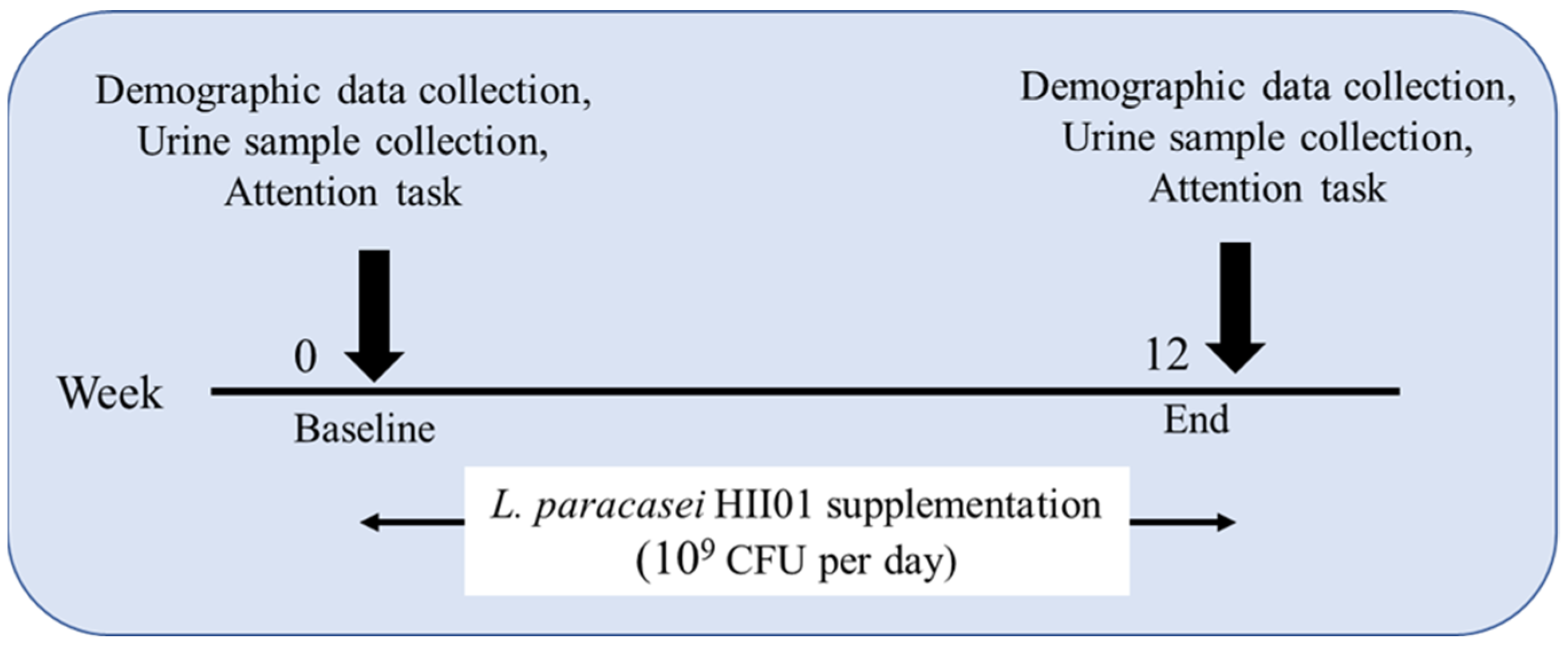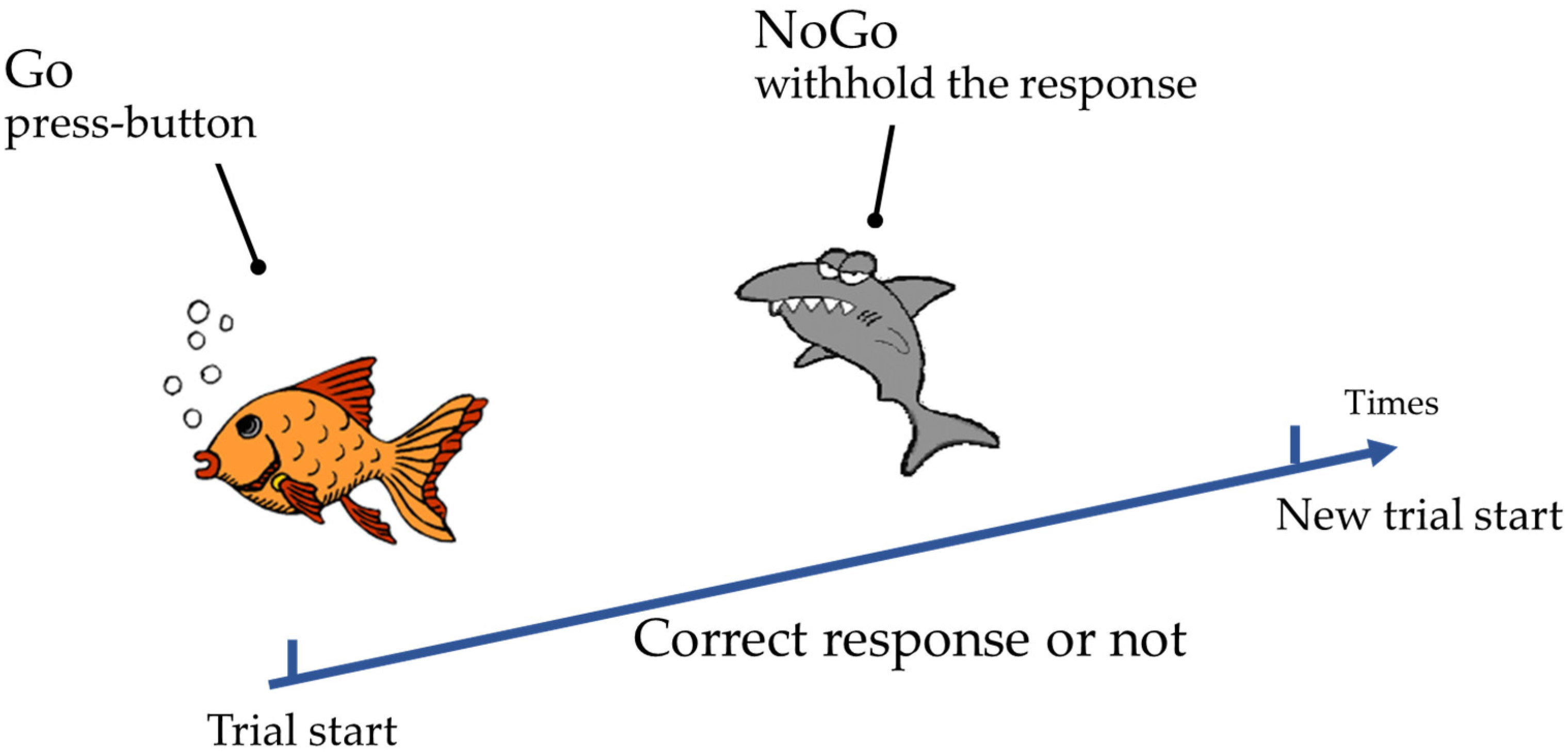The Influence of Lactobacillus paracasei HII01 Supplementation on Performance in Attention (Go/No-Go) Tasks and Quinolinic Acid and 5-Hydroxyindoleacetic Acid Levels in Thai Children—A Preliminary Study
Abstract
:1. Introduction
2. Materials and Methods
2.1. Subjects
2.2. Treatment
2.3. Assessments of Demographic Characteristics and Neuroinflammatory Markers
2.4. Assessment of Attentional Function
2.5. Statistical Analyses
3. Results
4. Discussion
5. Conclusions
Author Contributions
Funding
Institutional Review Board Statement
Informed Consent Statement
Data Availability Statement
Acknowledgments
Conflicts of Interest
References
- Stevens, C.; Bavelier, D. The role of selective attention on academic foundations: A cognitive neuroscience perspective. Dev. Cogn. Neurosci. 2012, 2, S30–S48. [Google Scholar] [CrossRef] [PubMed]
- Jacob, R.; Parkinson, J. The potential for school-based interventions that target executive function to improve academic achievement. Rev. Educ. Res. 2015, 85, 512–552. [Google Scholar] [CrossRef]
- Weintraub, S.; Dikmen, S.S.; Heaton, R.K.; Tulsky, D.S.; Zelazo, P.D.; Bauer, P.J.; Carlozzi, N.E.; Slotkin, J.; Blitz, D.; Wallner-Allen, K.; et al. Cognition assessment using the NIH Toolbox. Neurology 2013, 80, S54–S64. [Google Scholar] [CrossRef] [PubMed] [Green Version]
- Kumperscak, H.G.; Gricar, A.; Ülen, I.; Micetic-Turk, D. A pilot randomized control trial with the probiotic strain Lactobacillus rhamnosus GG (LGG) in ADHD: Children and adolescents report better health-related quality of life. Front. Psychiatry 2020, 11, 181. [Google Scholar] [CrossRef] [PubMed] [Green Version]
- Taylor, E.; Döpfner, M.; Sergeant, J.; Asherson, P.; Banaschewski, T.; Buitelaar, J.; Coghill, D.; Danckaerts, M.; Rothenberger, A.; Sonuga-Barke, E.; et al. European clinical guidelines for hyperkinetic disorder-first upgrade. Eur. Child Adolesc. Psychiatry 2004, 13, 17–30. [Google Scholar] [CrossRef]
- Van Loo, K.M.; Martens, G.J. Genetic and environmental factors in complex neurodevelopmental disorders. Curr. Genom. 2007, 8, 429–444. [Google Scholar] [CrossRef] [Green Version]
- Cenit, M.C.; Nuevo, I.C.; Codoñer-Franch, P.; Dinan, T.G.; Sanz, Y. Gut microbiota and attention deficit hyperactivity disorder: New perspectives for a challenging condition. Eur. Child Adolesc. Psychiatry 2017, 26, 1081–1092. [Google Scholar] [CrossRef]
- Pärtty, A.; Kalliomäki, M.; Wacklin, P.; Salminen, S.; Isolauri, E. A possible link between early probiotic intervention and the risk of neuropsychiatric disorders later in childhood: A randomized trial. Pediatr. Res. 2015, 77, 823–828. [Google Scholar] [CrossRef]
- Checa-Ros, A.; Jeréz-Calero, A.; Molina-Carballo, A.; Campoy, C.; Muñoz-Hoyos, A. Current evidence on the role of the gut microbiome in ADHD pathophysiology and therapeutic implications. Nutrients 2021, 13, 249. [Google Scholar] [CrossRef]
- Benton, D. The influence of children’s diet on their cognition and behavior. Eur. J. Nutr. 2008, 47, 25–37. [Google Scholar] [CrossRef]
- Nyaradi, A.; Li, J.; Hickling, S.; Foster, J.; Oddy, W.H. The role of nutrition in children’s neurocognitive development, from pregnancy through childhood. Front. Hum. Neurosci. 2013, 7, 97. [Google Scholar] [CrossRef] [PubMed] [Green Version]
- Sonuga-Barke, E.J.; Brandeis, D.; Cortese, S.; Daley, D.; Ferrin, M.; Holtmann, M.; Stevenson, J.; Danckaerts, M.; van der Oord, S.; Döpfner, M.; et al. Nonpharmacological interventions for ADHD: Systematic review and meta-analyses of randomized controlled trials of dietary and psychological treatments. Am. J. Psychiatry 2013, 170, 275–289. [Google Scholar] [CrossRef] [PubMed]
- Rosi, E.; Grazioli, S.; Villa, F.M.; Mauri, M.; Gazzola, E.; Pozzi, M.; Molteni, M.; Nobile, M. Use of non-pharmacological supplementations in children and adolescents with Attention Deficit/Hyperactivity Disorder: A critical review. Nutrients 2020, 12, 1573. [Google Scholar] [CrossRef]
- Hill, C.; Guarner, F.; Reid, G.; Gibson, G.R.; Merenstein, D.J.; Pot, B.; Morelli, L.; Canani, R.B.; Flint, H.J.; Salminen, S.; et al. Expert consensus document. The International Scientific Association for Probiotics and Prebiotics consensus statement on the scope and appropriate use of the term probiotic. Nat. Rev. Gastroenterol. Hepatol. 2014, 11, 506–514. [Google Scholar] [CrossRef] [PubMed] [Green Version]
- Wang, L.J.; Yang, C.Y.; Kuo, H.C.; Chou, W.J.; Tsai, C.S.; Lee, S.Y. Effect of Bifidobacterium bifidum on clinical characteristics and gut microbiota in Attention-Deficit/Hyperactivity Disorder. J. Pers. Med. 2022, 12, 227. [Google Scholar] [CrossRef]
- Sivamaruthi, B.S.; Suganthy, N.; Kesika, P.; Chaiyasut, C. The role of microbiome, dietary supplements, and probiotics in autism spectrum disorder. Int. J. Environ. Res. Public Health 2020, 17, 2647. [Google Scholar] [CrossRef] [Green Version]
- Kesika, P.; Sivamaruthi, B.S.; Chaiyasut, C. Do probiotics improve the health status of individuals with diabetes mellitus? A review on outcomes of clinical trials. BioMed Res. Int. 2019, 2019, 1531567. [Google Scholar] [CrossRef]
- Anee, I.J.; Alam, S.; Begum, R.A.; Shahjahan, R.M.; Khandaker, A.M. The role of probiotics on animal health and nutrition. JoBAZ 2021, 82, 52. [Google Scholar] [CrossRef]
- Sivamaruthi, B.S.; Kesika, P.; Chaiyasut, C. Influence of probiotic supplementation on health status of the dogs: A review. Appl. Sci. 2021, 11, 11384. [Google Scholar] [CrossRef]
- Kalenik, A.; Kardaś, K.; Rahnama, A.; Sirojć, K.; Wolańczyk, T. Gut microbiota and probiotic therapy in ADHD: A review of current knowledge. Prog. Neuropsychopharmacol. Biol. Psychiatry 2021, 110, 110277. [Google Scholar] [CrossRef]
- Segers, M.E.; Lebeer, S. Towards a better understanding of Lactobacillus rhamnosus GG-host interactions. Microb. Cell Fact. 2014, 13, S7. [Google Scholar] [CrossRef] [Green Version]
- Gomez, P.; Ratcliff, R.; Perea, M. A model of the go/no-go task. J. Exp. Psychol. Gen. 2007, 136, 389–413. [Google Scholar] [CrossRef] [PubMed]
- Sur, S.; Sinha, V.K. Event-related potential: An overview. Ind. Psychiatry J. 2009, 18, 70–73. [Google Scholar] [CrossRef] [PubMed]
- Stone, T.W.; Forrest, C.M.; Darlington, L.G. Kynurenines and brain development. In Targeting the Broadly Pathogenic Kynurenine Pathway, 1st ed.; Sandeep, M., Ed.; Springer: Cham, Switzerland, 2015; pp. 45–61. [Google Scholar]
- Spreux-Varoquaux, O.; Alvarez, J.C.; Berlin, I.; Batista, G.; Despierre, P.G.; Gilton, A.; Cremniter, D. Differential abnormalities in plasma 5-HIAA and platelet serotonin concentrations in violent suicide attempters: Relationships with impulsivity and depression. Life Sci. 2001, 69, 647–657. [Google Scholar] [CrossRef]
- Liao, K.; McCandliss, B.D.; Carlson, S.E.; Colombo, J.; Shaddy, D.J.; Kerling, E.H.; Lepping, R.J.; Sittiprapaporn, W.; Cheatham, C.L.; Gustafson, K.M. Event-related potential differences in children supplemented with long-chain polyunsaturated fatty acids during infancy. Dev. Sci. 2017, 20, e12455. [Google Scholar] [CrossRef]
- Haag, M. Essential fatty acids and the brain. Can. J. Psychiatry 2003, 48, 195–203. [Google Scholar] [CrossRef]
- Lehmann, D.; Skrandies, W. Principles of spatial analysis. In Methods of Analysis of Brain Electrical and Magnetic Signals (Handbook of Electroencephalography and Clinical Neurophysiology, Revised Series), 1st ed.; Gevins, A.S., Remond, A., Eds.; Elsevier Science Ltd.: Amsterdam, The Netherlands, 1987; Volume 1, pp. 309–354. [Google Scholar]
- Pascual-Marqui, R.D.; Michel, C.M.; Lehmann, D. Segmentation of brain electrical activity into microstates: Model estimation and validation. IEEE Trans. Biomed. Eng. 1995, 42, 658–665. [Google Scholar] [CrossRef]
- Skrandies, W. Global field power and topographic similarity. Brain Topogr. 1990, 3, 137–141. [Google Scholar] [CrossRef]
- Bann, S.A.; Herdman, A.T. Event Related Potentials Reveal Early Phonological and Orthographic Processing of Single Letters in Letter-Detection and Letter-Rhyme Paradigms. Front. Hum. Neurosci. 2016, 10, 176. [Google Scholar] [CrossRef] [Green Version]
- Aarsland, T.I.; Landaas, E.T.; Hegvik, T.A.; Ulvik, A.; Halmoy, A.; Ueland, P.M.; Haavik, J. Serum concentrations of kynurenines in adult patients with attention deficit hyperactivity disorder (ADHD): A case-control study. Behav. Brain Funct. 2015, 11, 36. [Google Scholar] [CrossRef] [Green Version]
- Oades, R.D.; Dauvermann, M.R.; Schimmelmann, B.G.; Schwarz, M.J.; Myint, A.M. Attention-deficit hyperactivity disorder (ADHD) and glial integrity: S100B, cytokines and kynurenine metabolism-effects of medication. Behav. Brain Funct. 2010, 6, 29. [Google Scholar] [CrossRef] [PubMed] [Green Version]
- Evangelisti, M.; De Rossi, P.; Rabasco, J.; Donfrancesco, R.; Lionetto, L.; Capi, M.; Sani, G.; Simmaco, M.; Nicoletti, F.; Villa, M.P. Changes in serum levels of kynurenine metabolites in paediatric patients affected by ADHD. Eur. Child Adolesc. Psychiatry 2017, 26, 1433–1441. [Google Scholar] [CrossRef] [PubMed]
- Lugo-Huitrón, R.; Ugalde Muñiz, P.; Pineda, B.; Pedraza-Chaverrí, J.; Ríos, C.; Pérez-de la Cruz, V. Quinolinic acid: An endogenous neurotoxin with multiple targets. Oxidative Med. Cell. Longev. 2013, 2013, 104024. [Google Scholar] [CrossRef] [Green Version]
- Jayamohanan, H.; Kumar, M.K.M.; Aneesh, T.P. 5-HIAA as a Potential Biological Marker for Neurological and Psychiatric Disorders. Adv. Pharm. Bull. 2019, 9, 374–381. [Google Scholar] [CrossRef] [PubMed] [Green Version]
- Morimoto, S.; Takao, M.; Hatsuta, H.; Nishina, Y.; Komiya, T.; Sengoku, R.; Nakano, Y.; Uchino, A.; Sumikura, H.; Saito, Y.; et al. Homovanillic acid and 5-hydroxyindole acetic acid as biomarkers for dementia with Lewy bodies and coincident Alzheimer’s disease: An autopsy-confirmed study. PLoS ONE 2017, 12, e0171524. [Google Scholar] [CrossRef] [PubMed]
- Mishima, Y.; Ishihara, S. Enteric microbiota-mediated serotonergic signaling in pathogenesis of irritable bowel syndrome. Int. J. Mol. Sci. 2021, 22, 10235. [Google Scholar] [CrossRef] [PubMed]
- Breitling-Ziegler, C.; Tegelbeckers, J.; Flechtner, H.H.; Krauel, K. Economical Assessment of Working Memory and Response Inhibition in ADHD Using a Combined n-back/Nogo Paradigm: An ERP Study. Front. Hum. Neurosci. 2020, 14, 322. [Google Scholar] [CrossRef]
- Michałowski, J.M.; Wiwatowska, E.; Weymar, M. Brain potentials reveal reduced attention and error-processing during a monetary Go/No-Go task in procrastination. Sci. Rep. 2020, 10, 19678. [Google Scholar] [CrossRef]
- Thiele, A.; Bellgrove, M.A. Neuromodulation of Attention. Neuron 2018, 97, 769–785. [Google Scholar] [CrossRef] [Green Version]
- Buskila, Y.; Bellot-Saez, A.; Morley, J.W. Generating brain waves, the power of astrocytes. Front. Neurosci. 2019, 13, 1125. [Google Scholar] [CrossRef] [Green Version]
- Wilckens, K.A.; Ferrarelli, F.; Walker, M.P.; Buysse, D.J. Slow-wave activity enhancement to improve cognition. Trends Neurosci. 2018, 41, 470–482. [Google Scholar] [CrossRef] [PubMed]



| Parameters | Baseline | 12 Weeks | p-Value * |
|---|---|---|---|
| Age (years) | 9.50 ± 0.50 | ||
| Male, n (%) | 6 (60) | ||
| Female, n (%) | 4 (40) | ||
| Bodyweight (kg) | 55.62 ± 5.18 | 55.68 ± 5.00 | 0.885 |
| Parameters | Baseline | 12 Weeks | p-Value |
|---|---|---|---|
| QA (ng/mL) | 26.73 ± 1.42 | 19.64 ± 1.08 | 0.004 a* |
| 5-HIAA (mg/L) | 2.91 ± 0.44 | 7.28 ± 1.19 | 0.005 b* |
| QA/5-HIAA ratio | 0.0109 ± 0.001 | 0.0043 ± 0.001 | 0.005 b* |
| Parameters | Baseline | 12 Weeks | p-Value |
|---|---|---|---|
| Go accuracy (%) | 85.58 ± 2.46 | 97.92 ± 0.97 | 0.001 a* |
| Go error (%) | 14.42 ± 2.46 | 2.08 ± 0.97 | 0.006 b* |
| No-go accuracy (%) | 88.25 ± 3.36 | 90.75 ± 3.23 | 0.389 a |
| No-go error (%) | 11.75 ± 3.38 | 9.25 ± 3.23 | 0.324 b |
| Go response time (ms) | 599.19 ± 32.57 | 610.61 ± 32.99 | 0.649 a |
Publisher’s Note: MDPI stays neutral with regard to jurisdictional claims in published maps and institutional affiliations. |
© 2022 by the authors. Licensee MDPI, Basel, Switzerland. This article is an open access article distributed under the terms and conditions of the Creative Commons Attribution (CC BY) license (https://creativecommons.org/licenses/by/4.0/).
Share and Cite
Fukngoen, P.; Sivamaruthi, B.S.; Sirilun, S.; Lalitsuradej, E.; Khongtan, S.; Peerajan, S.; Sittiprapaporn, P.; Chaiyasut, C. The Influence of Lactobacillus paracasei HII01 Supplementation on Performance in Attention (Go/No-Go) Tasks and Quinolinic Acid and 5-Hydroxyindoleacetic Acid Levels in Thai Children—A Preliminary Study. Appl. Sci. 2022, 12, 5658. https://doi.org/10.3390/app12115658
Fukngoen P, Sivamaruthi BS, Sirilun S, Lalitsuradej E, Khongtan S, Peerajan S, Sittiprapaporn P, Chaiyasut C. The Influence of Lactobacillus paracasei HII01 Supplementation on Performance in Attention (Go/No-Go) Tasks and Quinolinic Acid and 5-Hydroxyindoleacetic Acid Levels in Thai Children—A Preliminary Study. Applied Sciences. 2022; 12(11):5658. https://doi.org/10.3390/app12115658
Chicago/Turabian StyleFukngoen, Pranom, Bhagavathi Sundaram Sivamaruthi, Sasithorn Sirilun, Ekasit Lalitsuradej, Suchanat Khongtan, Sartjin Peerajan, Phakkharawat Sittiprapaporn, and Chaiyavat Chaiyasut. 2022. "The Influence of Lactobacillus paracasei HII01 Supplementation on Performance in Attention (Go/No-Go) Tasks and Quinolinic Acid and 5-Hydroxyindoleacetic Acid Levels in Thai Children—A Preliminary Study" Applied Sciences 12, no. 11: 5658. https://doi.org/10.3390/app12115658
APA StyleFukngoen, P., Sivamaruthi, B. S., Sirilun, S., Lalitsuradej, E., Khongtan, S., Peerajan, S., Sittiprapaporn, P., & Chaiyasut, C. (2022). The Influence of Lactobacillus paracasei HII01 Supplementation on Performance in Attention (Go/No-Go) Tasks and Quinolinic Acid and 5-Hydroxyindoleacetic Acid Levels in Thai Children—A Preliminary Study. Applied Sciences, 12(11), 5658. https://doi.org/10.3390/app12115658









